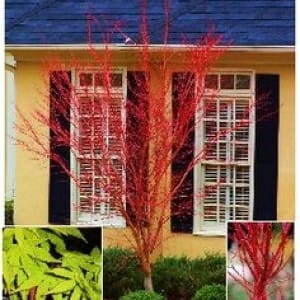 Winter is here and the days are short and gray. Even though the weather is blustery, there is still plenty to appreciate in our urban forest. There may not be many flowers, and most of the colorful leaves of autumn have fallen. However, wintertime also brings unique opportunities for color. Winter interest plants can create beauty in your yard even during the most dismal months. If your landscape is a bit drab at the moment, this is the perfect time to let our Portland certified arborists help you research which species can add life to your landscaping in the wintertime.
Winter is here and the days are short and gray. Even though the weather is blustery, there is still plenty to appreciate in our urban forest. There may not be many flowers, and most of the colorful leaves of autumn have fallen. However, wintertime also brings unique opportunities for color. Winter interest plants can create beauty in your yard even during the most dismal months. If your landscape is a bit drab at the moment, this is the perfect time to let our Portland certified arborists help you research which species can add life to your landscaping in the wintertime.
Portland Certified Arborists’ Tips on Winter Interest Trees
Think Evergreen. Here in the Pacific Northwest we are graced with some of the largest evergreens on the planet. Don’t take them for granted. Our evergreens provide a comfortable backdrop and also work hard as valuable structural plants in the landscape. Rhododendrons, Camellias, Andromeda, Cypress, and other evergreen species work well in our wet winters. Broadleaf evergreens such as Southern Magnolia and Madrone, while larger trees, also work well in our Pacific Northwest climate.
Go for Contrast. Evergreens make a nice backdrop for other plants such as Red-Osier Dogwood (Cornus sericea) or Coral-Bark Maple (Acer palmatum “Sango Kaku”). Birchbark Cherry (Prunus serrula) and Himalayan Birch (Betula jacquemontii) also have nicely-textured bark. Winter interest plants might not be known for their flowers, but they have other features such as multi-layered or brightly colored bark that provide rich textures in the landscape.
Winter Flowers. Hope is not lost for those looking for winter flowers. Witch hazel (Hamamelis) may still be found blooming in December in some Portland gardens. Evergreen shrubs such as Andromeda and Daphe odora also flower in winter. These can be matched with evergreen or flowering perennials, such as hellebores, or shrubs, such as Hazel, with its twisting branches and flowering catkins.
Zen-Inspired Gardens. These gardens bring peace and tranquility to the landscape and to the inner mind, and provide a welcome respite from the worries of the city. The good thing about Japanese and Chinese style gardens (we have lovely examples of both in Portland) is that they focus not on showy flowers but on creating harmony with the natural backdrop that our large conifers provide. Many of the plants listed above also work well in Zen-inspired gardens. Japanese Maples are a classic Zen garden selection, particularly those varieties that boast vibrant or textured bark. The leafless silhouette of a Japanese maple is, on its own, the perfect fodder for meditation. Hinoki Cypress (Chameacyparis), Yew Plum (Cephalotaxus), Colorado Blue Spruce (Picea pungens), and Mugo Pine (Pinus mugo “Teeny”) are good choices for Japanese- and Chinese-style gardens, and these species grow well in our climate. Learn more about Pruning a Japanese Maple.
The Snow Garden. Snow brings the perfect opportunity for winter gardening. The idea is to plan ahead for the stark contrast of snow. For instance, while cutting back perennials in the fall, you can leave long spiky flowers to dry in place. Snow will provide a magical, white backdrop for the flower stalks. This can be complimented with the plants or techniques listed above for background or additional interest. Another idea is to plant a deciduous Larch. These unique conifer trees drop their needles in the winter. Imagine the breathtaking effect of a Larch’s newly fallen needles on a soft bed of new snow.
Think ahead: Portland Tree Planting and Pruning. Take good care of your yard’s landscape and it will provide a wonderful environment to enjoy, even during the winter months. Preparation is a key ingredient for a successful winter garden. Design is one of our Portland tree services, and we would love to create and plant a living palette of year-round color for your yard. From species selection, to pruning, to removal, and tree planting, Portland homeowners can trust UFP with any tree-related need. Our arborists are ISA-certified, fully licensed, and insured. We take care to do the job right because we know that is what you expect, and because we are passionate about the health of our urban forest. Call us today to discuss our tree-planting services.
This post first appeared on https://www.urbanforestprofessionals.com